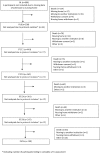Mortality in nursing home residents: A longitudinal study over three years
- PMID: 30226850
- PMCID: PMC6143238
- DOI: 10.1371/journal.pone.0203480
Mortality in nursing home residents: A longitudinal study over three years
Abstract
Objective: Nursing home (NH) stay is the highest level of formal care. With the expected demographic changes ahead, the need for NH placement will put an increasing socioeconomic strain on the society. Survival in NHs and factors predicting survival are important knowledge in order to evaluate NH admission policies and plan future NH capacity.
Methods: We followed 690 NH residents included at admission to NH over a period of three years. Participants were examined at baseline (BL) and every six months. Demographic and clinical data were collected, including comorbidity, severity of cognitive impairment, dependency in activities of daily living (ADL) and neuropsychiatric symptoms. Median survival was calculated by the Kaplan-Meier analysis, and factors associated with mortality were identified by Cox models with baseline and time-dependent covariates.
Results: Median survival in NH was 2.2 years (95% confidence interval [CI]: 1.9-2.4). Yearly mortality rate throughout the three-year observation period was 31.8%. Mortality was associated with higher age and comorbidity at BL, and more severe dementia, higher ADL-dependency, less severe psychotic symptoms, and a lower BMI throughout the study period. Of the organizational variables, living on a ward with more residents resulted in a higher risk of mortality.
Conclusion: In conclusion, the NH mortality rate remained stable throughout the three-year study period with about one third of the residents deceasing each year. Individual resident characteristics appeared to be more important than organizational variables for predicting mortality risk. The finding of an association between ward size and mortality risk deserves further investigation in future studies.
Conflict of interest statement
The authors have declared that no competing interests exist.
Figures
References
-
- Vossius C, Selbæk G, Ydstebo A, Benth JS, Godager G, Luraas H. Ressursbruk og sykdomsforløp ved demens (REDIC). Sykehuset Innlandet, Report. 2015:1–155.
-
- Wieland D, Boland R, Baskins J, Kinosian B. Five-year survival in a program of all-inclusive care for elderly compared with alternative institutional and home- and community-based care. The journals of gerontology Series A, Biological sciences and medical sciences. 2010;65(7):721–6. Epub 2010/04/01. 10.1093/gerona/glq040 - DOI - PubMed
Publication types
MeSH terms
LinkOut - more resources
Full Text Sources
Other Literature Sources
Medical



